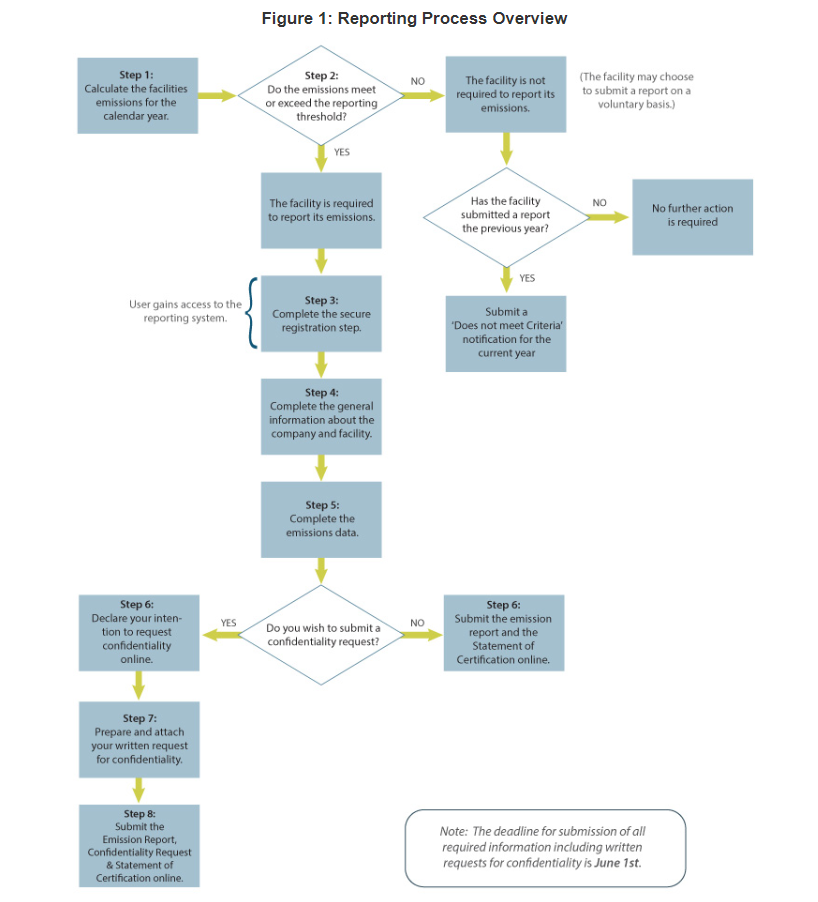1: GHG REPORTING PROGRAM
Environment and Climate Change Canada’s (ECCC) Greenhouse Gas Reporting Program (GHGRP) describes the mandatory reporting of GHGs (CO2, CH4, N2O, SF6, HFCs, PFCs) above a certain threshold in Canada. Although it has been in effect since 2004, changes were made to the GHGRP in 2017 that lowered the reporting threshold from 50,000 tonnes of CO2e to 10,000 tonnes of CO2eq. PDAC worked with Avalon Advanced Materials to determine that large-scale exploration drilling programs (i.e. in the order of 200,000 meters/year or operations with 10 or more drills) could produce sufficient GHG emissions to trigger this monitoring and reporting requirement. If your facility* is required to report, you must do so by June 1st annually.
GHG Emissions Calculator
The flow chart below from ECCC, will also provide a better understanding of the GHGRP reporting process.

For more information on GHGRP requirements, please see: https://www.canada.ca/en/environment-climate-change/services/climate-change/greenhouse-gas-emissions/facility-reporting.html
* ECCC defines “facility” as a contiguous facility, a pipeline transportation system or an offshore installation. A “contiguous facility” means all buildings, equipment, structures and stationary items that are located on a single site or on contiguous or adjacent sites; that are owned or operated by the same person and that function as a single integrated site; and include wastewater collection systems that discharge treated or untreated wastewater into surface waters.
2: FEDERAL CARBON PRICING “BACKSTOP”
At the end of 2016, the Government of Canada released its Pan-Canadian Framework on Clean Growth and Climate Change (the “Framework”) for mitigating the impacts of climate change and meeting Canada’s climate reduction targets (to reduce economy-wide GHG emissions by 30% below 2005 levels by 2030). A key component of the Framework was a commitment to put a price on carbon emissions across Canada by September 1, 2018. Provinces and territories that do not already have a carbon pricing mechanism in place, or one that meets the thresholds prescribed by the federal government, will be required to adopt the federal government’s carbon pricing “backstop” outlined in the Greenhouse Gas Pollution Pricing Act . The backstop contains two elements:
- A charge on fossil fuels, that is generally payable by fuel producers or distributors, with rates for each fuel that are equivalent to $10 per tonne of CO2eq in 2018, rising by $10 per year to $50 per tonne in 2022, then rising by $15 per year to $170 per tonne in 2030.
- An output-based pricing system (OBPS) for industrial facilities emitting over 50,000 tonnes of CO2eq per year.
Impact of a Carbon Price on Fuel Costs
The impact of a $10 per tonne of CO2eq emitted and $50 per tonne of CO2eq on the price of key petroleum products is shown below. Whether the tax is paid at the pump or in a site-level carbon tax, given the hundreds of thousands of gallons of diesel that can be consumed at a drill site, the costs can add up.
|
Fuel
|
Cost/liter in 2018
|
Cost/liter in 2022
|
Cost/liter in 2030
|
|
Gasoline
|
2.3 cents
|
11.63 cents
|
37.4 cents
|
|
Diesel
|
2.7 cents
|
13.69 cents
|
45.4 cents
|
|
Propane
|
1.5 cents
|
7.74 cents
|
26.3 cents
|
For more information on the carbon pricing backstop, please visit: https://www.canada.ca/en/services/environment/weather/climatechange/technical-paper-federal-carbon-pricing-backstop.html
For more detailed information on the fuel charge rates please visit:
https://www.canada.ca/en/revenue-agency/services/forms-publications/publications/fcrates/fuel-charge-rates.html#fcrts
For ways to reduce your GHG emissions, click here.
GHG Emissions Calculator
3: CLEAN FUEL REGULATIONS
On November 25, 2016, the Government of Canada announced it would consult with provinces and territories, Indigenous Peoples, industries, and NGOs to develop a Clean Fuel Standard. Following consultations in early 2017, the Government of Canada published the clean fuel standard regulatory framework. Following multiple delays and revisions, these regulations came into force in July 2023.
The Clean Fuel Regulations are predominantly relevant to primary fuel suppliers. It establishes a carbon credit market that awards credits for improvements to production facilities (such as carbon capture and storage, on-site renewable electricity, and co-processing), lowering the carbon intensity of the actual fuel (such as producing or using ethanol, biodiesel, or renewable natural gas) and offering electric vehicle charging and hydrogen vehicle fuelling. Primary suppliers may choose to contribute to a registered Emission Reduction Funding Program under the Clean Fuel Regulations to satisfy up to 10% of its annual carbon intensity reduction requirement. Adding more ethanol to gasoline and diesel is likely the most common way that industry will comply.
The Clean Fuel Regulation aims to achieve 26 megatonnes of annual reductions in GHG emissions by 2030 and applies to liquid, gaseous and solid fuels combusted for the creation of energy.